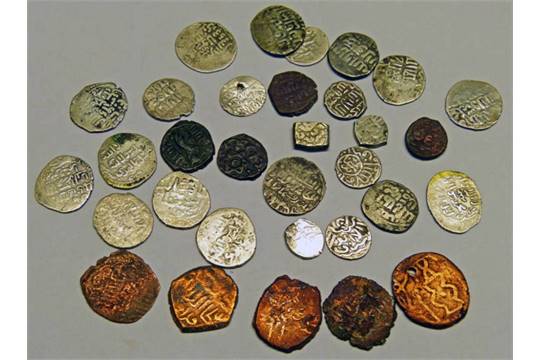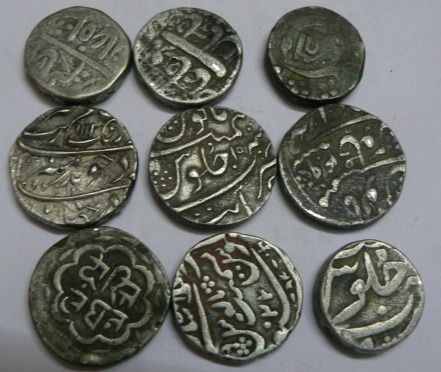Sultanate Period
In 11th century during the reign of Raj put kings, the period of Muslim rulers came in to origin as with the invasion of ‘Mahmud of Ghazni’, and the coins belonging to the heirs of ‘Mahmud of Ghazni’ namely ‘Farrukhazad’, ‘Ibrahim’, ‘Bah ram Shah’ etc. came in to circulation. These coins were made of the alloy consisting copper and silver and were very much like the coins issued by previous ‘Raj put Kings’ bearing the figure of ‘Horseman’, on one side and ‘Bull’ on other side. ‘Khusru Malik ‘belonging to the ‘Ghazni’ dynasty was the last ruler as with the invasion of the Turkish ‘Muhammad bin Sam’ alias ‘Muhammad Gori’ in ‘India’ with large army and defeating Hindu King ‘Prithviraj Chauhan’ and resulting in the origin of another Muslim Dynasty in the end of 12th century, and was called ‘Slave Dynasty’ or the period of ‘Delhi Sultans’. During this period five different families ruled through Delhi and lasted till the coming of ‘Babur’ who was the founder of ‘Mughal Dynasty’ in India.



The first dynasty among the ‘Delhi Sultans’ was ‘Slave dynasty’, as the founder of this dynasty naming ‘Qutb ud din Aibak’ was the slave of ‘Muhammad Gori’. The main rulers belonging to this dynasty were ‘Qutub ud din Aibak’, ‘Shams ud din Iltutmish’, who also built the ‘Qutb Minar’ at Delhi, ‘Rukn ud din Firuz Shah 1st ‘, ‘Begum Jalalat ud din Raziyya’, ‘Muizz ud din Bahram Shah’, ‘Ala ud din Masud Shah’, ‘Nassir ud din Mahmud Shah 1st ’, ‘Ghiyas ud din Balban Shah’, Muizz ud din Kaiqubad’, ‘Shams ud din Kayumars’ etc. It is here noticeable that ‘Begum Raziyya’ was the first woman in Indian history who was enthroned as a Queen of the Sultanate. A notable feature of the coins of ‘Raziyya’ is that she did not place her name on the coins but retained the name of her father. The only indication that the coins were issued by her is the date and the word ‘Nusrat’ in the last line on the reverse. She aroused the resentment of the nobles by appointing an African named ‘Jala ud din Yaqub’ to the post of master of the horse, and distinguishing him with her favor.

In the end of 13th century an another dynasty naming ‘Khilji Dynasty’ came into origin and the chief rulers of this dynasty were ‘Jalal ud din Firuz Shah 2nd ’, ‘Rukn ud din Ibrahim’, ‘Ala ud din Muhammad Shah 2nd ’, ‘Shihab ud din Umar Shah’, ‘Qutub ud din Mubarak Shah 1st ’ etc. The coin of ‘Rukn ud din Ibrahim’ son of ‘Jalal ud din Firuze’ is considered valuable among the coin collectors as he was the King for only few days. As after the murder of ‘Firuz’ by ‘Ala ud din Muhammad Shah 2nd ‘ ,the widow of ‘Firuz’ proclaimed his younger son ‘Rukn ud din Ibrahim’ as King, but when ‘Muhammad 2nd ‘ with a large army entered Delhi ‘Ibrahim’, after a feeble demonstration, fled towards Multan.

During 14th century third dynasty naming ‘Tughluq Dynasty’, ruled through Delhi and the major rulers belonging to this dynasty were ‘Ghiyas ud din Tughluq Shah 1st ’, ‘Fakhr ud din Muhammad 3rd bin Tughluq Shah’, ‘and ‘Firoze Shah 3rd Tughluq’ etc. ‘Muhammad bin Tughluq’ was famous for his eccentric behavior in Indian history. He shifted his capital from ‘Delhi’ to ‘Daulatabad’ in the Deccan and forced people to move there and during the course of shifting capital many people died. On the other hand his successor to the throne his son ‘Firoze Shah 3rd ‘, encouraged agriculture and ‘Firozabad ’, ‘Fathabad’, ‘Hissar’, ‘Firuzpur’, and ‘Jaunpur’, were the towns founded by him. ‘Firuz’, for the welfare of his subjects, introduced Marriage and Employment Bureaus.

In the beginning of 15th century forth dynasty came in to existence naming ‘Sayyid Dynasty’ founded by ‘Khizr Khan’ and it reigned through the throne of Delhi only for approximately 30 years and only three rulers issued their coins namely ‘Muizz ud din Mubarak Shah 2nd ’, ‘Muhammad Shah 5th bin Farid Shah’ and ‘Alam Shah’. Only a few coins of the last ruler of the dynasty, ‘Alam Shah’ are known and coins belonging to the Sayyid Dynasty’ keep an important position among the coin collectors.

‘Alam Shah’ belonging to the ‘Sayyid Dynasty’ was feebler and vacillating, he voluntarily abdicated the throne in favor of ‘Bahlul Lodi’ belonging to the ‘Lodi Dynasty’ resulting in the formation of the fifth dynasty naming ‘Lodi Dynasty’. The chief rulers of this dynasty were ‘Bahlul Lodi’, ‘Sikandar Shah 2nd Lodi’, and ‘Ibrahim Shah 2nd Lodi’. During the ‘Sultanate Period’ the coins were made in copper, billon, silver and gold.



